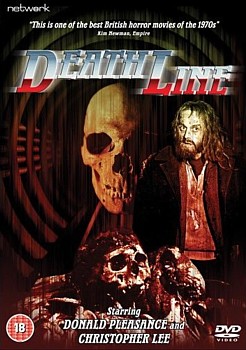
DEATH LINE
UK, 1972, 87 minutes, Colour.
Donald Pleasence, Norman Rossington, Christopher Lee, David Ladd, Sharon Gurney.
Directed by Gary Sherman.
Death Line, grossly re-titled Raw Meat, seems to be something of a horror classic. It succeeds very entertainingly in its portrayal of London police with Donald Pleasence giving one of his best performances, finely comic. Christopher Lee also appears briefly but tellingly. On the horror level, the picture of a lone survivor of an accident under London's tube is filmed with gruesome excellence, gaining sympathy for the human monster, giving him a Dickensian atmosphere and relying on the Beauty and the Beast fable. An innocuous young American couple provide the focus of excitement. But the film's blend of humour and horror make it a worthwhile example of the genre.
1. What was the ultimate impact of this film on the audience? Was it an enjoyable horror film? Why? Was it a well-made horror film? Why?
2. How well did the film use the conventions of the English Police drama? The character of the inspector and his assistant, the police woman with the cups of tea, the advice on historical aspects of London, the inspection of blood and the scientists? The portrayal of character, the emphasis on humour and deadpan dialogue, the reality of the investigations. Did the film develop these successfully and integrate them with the horror?
3. How successful a horror film was this? Did it frighten the audience successfully? Did it create an atmosphere of horror? Did it exploit horror and the audience? Its use of blood and gore? How interesting was the basic horror story? The historical explanation? The portrayal of the man and the woman and life on the death line? The killings and the chases at the end? Conventional or better?
4. The visual presentation of the man for the film and its impact? As figure of horror, half-human, a monster, but how humane was he? The use of the Beauty and the Beast theme for the monster? His relationship with his wife, inarticulate, the use of the victims for blood, his kidnapping the girl, the importance of his death and its pathos, his final cry? How well did the film in this character balance brutality and feeling?
5. Comment on the quality of the visual impact of the film - the goriness of the deaths, the refrigerators of the corpses, yet the muted colour, the framing of 19th century style pictures, the Beauty and the Beast theme, the portrayal of the man as a mythical character, the humanity of his chase with the lantern, his relationship with the girl, the pathos of his death and final call? The contrast of this with the garish beginning and the ordinariness of modern London?
6. How well did the film utilise violence? Did it exploit it?
7. The tone of the opening, its music, its garish colour, striptease world; the politics, in this world? The ugly tones of the modern world compared with the underground?
8. How attractive were the hero and heroine? Credible? The ordinary scenes at home, their studies and work in the bookshop, their conversation, and yet the conventions of the horror film the kidnapping and the chase, the relationship with the police? Did they fit in well with the rest of the film?
9. The film’s utilising of modern London to make the whole story credible. Was it successful here?
10. The implications of social comment in the history of the collapse of the underground and the companies not rescuing the victims, the murders as some kind of reeking with justice?
11. Comment on the success of the dialogue, the humour, Donald Pleasence's performance and style, the interlude with Christopher Lee and the M15 style, the intercutting of modern London with the underground?
12. How successful an English horror film was this?